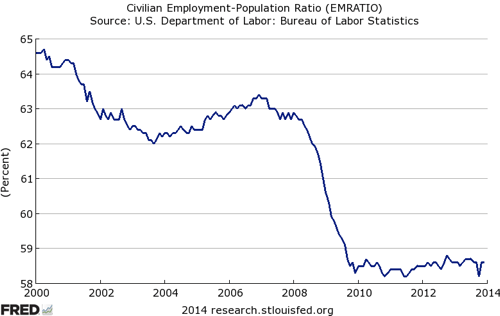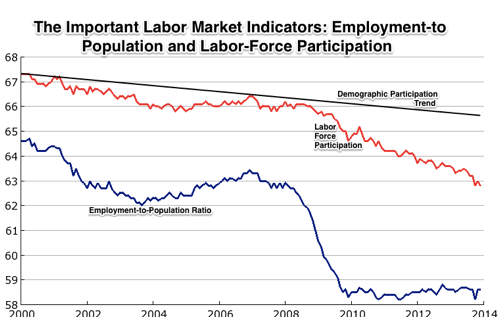This Is Yet Another in the 56-Month Straight Series of Disappointing and Awful Bureau of Labor Statistics Household Employment Surveys: Friday Focus
From April 2008 to October 2009, the household employment survey results were disappointing and awful as the chronicled the collapse of employment in America. And since November 2009, the household employment survey results have been disappointing and awful as they have chronicled the flat-lining of the employment-to-population ratio: no greater a proportion of Americans have jobs now than had them in October 2009.

But, you might say: The employment-to-population ratio would have declined anyway because demography. Yes, but 0.5% points. Maybe 0.8% points if you push the demography coefficients to the very edge of their envelope. Not 4.8% points below its 2007 business-cycle peak, and 6.0% points below its 2000 business-cycle peak.
But, you might say: The unemployment rate! The unemployment rate is way down!! The unemployment rate is down from 10.0% to 6.7%!!! YAY!!!!
In fact, if you are Jason Furman, Chairman of President Barack Obama’s Council of Economic Advisors, the phrase “employment-to-population ratio” is found nowhere in what you write. What you write is:
Jason Furman: The Employment Situation in December: “FIVE KEY POINTS IN TODAY’S REPORT FROM THE BUREAU OF LABOR STATISTICS
1) America’s resilient businesses have added jobs for 46 consecutive months, with private sector employment increasing by 8.2 million over that period…. 2) The overall unemployment rate declined to 6.7 percent in December, the lowest since October 2008, but the lingering elevation in the unemployment rate is due to the large number of persons unemployed for more than 27 weeks…. 3) With the expiration of the EUC program at the end of December, the share of the unemployed receiving jobless benefits is likely to fall to the lowest on record…. 4) As of December 2013, the long-term unemployment rate remains markedly elevated, and recent temporary federal unemployment insurance programs have only expired when the long-term unemployment rate was roughly half of what it is now…. 5) While the unemployment rate is still too high, it is trending down, with declines for key demographic groups.
All true, but missing–and most important–is the fact that the reason the unemployment rate is trending down is not because the employment-to-population ratio is rising but because labor force participation is falling.
-
To the extent that those dropping out of the labor force will return when the labor market strengthens, the declining unemployment rate is irrelevant–the strength of the labor market is then best measured by the employment-to-population ratio.
-
To the extent that those dropping out of the labor force won’t return when the labor market strengthens, the declining unemployment rate coupled with the flat-lining employment-to-population ratio is an absolute and total complete disaster: a permanent reduction in the efficiency of the American economy at matching potential workers who could use jobs with potential jobs that could use workers, and a permanent injury to America’s wealth and productive potential.


